San Francisco’s Tu Quang Temple: Vietnamese Buddhism and Regeneration in the Heart of the City

Down the hill from the San Francisco Mint towards a bustling intersection at Duboce Avenue and Market Street, the beautiful blue and white sculptural relief of the Buddhist Goddess Guanyin in flowing gowns juts out from a bright yellow building. The front of the building, which includes other ornate details such as a Dharma Wheel on the second floor, guardian lions at the front door and dragons on the rooftop, is hard to miss.
This is the Tu Quang Temple and Vietnamese Buddhist Association of San Francisco, a central place of worship and community for Vietnamese populations in San Francisco and the greater Bay Area. Like many religious sites in San Francisco, the Tu Quang Temple has both an interesting history and a lively existence into the present day. This article includes historical analysis, as well as original interviews and photographs.
Anna Hennessey, PhD
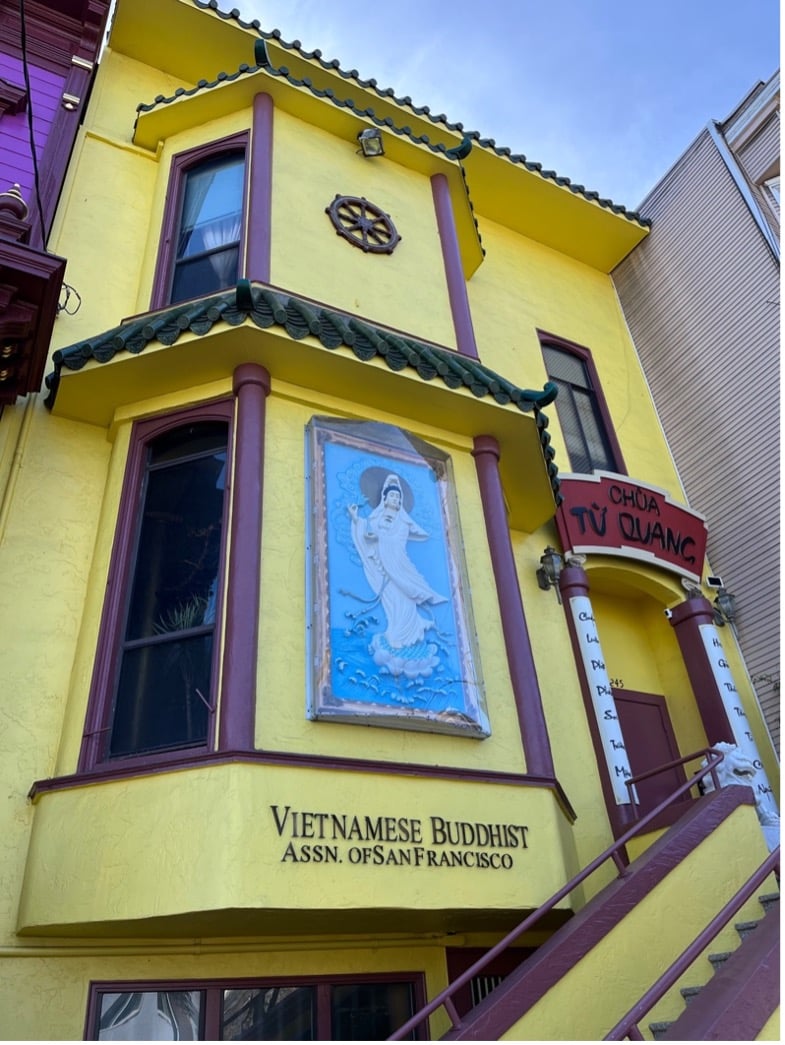
Photo, copyright 2023, Anna Hennessey
Down the hill from the San Francisco Mint towards a bustling intersection at Duboce Avenue and Market Street, the beautiful blue and white sculptural relief of the Buddhist Goddess Guanyin in flowing gowns juts out from a bright yellow building. The front of the building, which includes other ornate details such as a Dharma Wheel on the second floor, guardian lions at the front door and dragons on the rooftop, is hard to miss. This is the Tu Quang Temple and Vietnamese Buddhist Association of San Francisco, a central place of worship and community for Vietnamese populations in San Francisco and the greater Bay Area.
Like many religious sites in San Francisco, the Tu Quang Temple has both an interesting history and a lively existence into the present day. In 1976, Grand Master Thich Tinh Tu established the temple. The Grand Master, who now resides at the Kim Son Monastery in Watsonville near to San Jose, California (established in 1983), left Vietnam for the United States in 1974. Over the past five decades, he has founded several Buddhist temples and retreats in the San Francisco Bay Area and across the United States, both for Vietnamese people and Vietnamese refugees who fled their homeland, as well as for others seeking to learn about Vietnamese Buddhism. Tu Quang Temple is part of The Vietnamese Sangha Congregation in America, which is associated more broadly with the Unified Buddhist Sangha of Vietnam. The latter developed to unify Buddhists in South Vietnam in 1964 during a time when Buddhists faced increased persecution during the Vietnam War. The Vietnamese government banned the Unified Buddhist Sangha in 1981.
The Tu Quang temple occupies a building previously run for decades during the twentieth century as a Korean Presbyterian church. In 1978, several Vietnamese Buddhist practitioners converted the main space of the Korean church into a Vietnamese Buddhist temple. They removed benches that had been used in the church, installing a deep red wall to wall carpet, as well as multiple statues and other Buddhist artwork. The school of Buddhism followed at Tu Quang is Mahayana, also known as the “Great Vehicle,” which predominates in Vietnam. One of the temple’s main Mahayana artworks, a large figure of the Buddha, rests at the center of the shrine in the main hall.
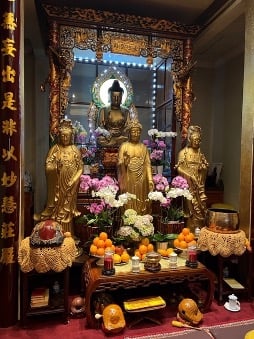
Photo, copyright 2023, Anna Hennessey
In 2005, the association purchased the striking sculptural relief of Guanyin. The goddess rests on a floating lotus flower and has a golden halo around her head. Her white form merges with the blue swirls of the painted sky and sea, contrasting nicely with the bright yellow color of the building. Chris Nguyen, a Vietnamese artist from San Jose who has studied sculpture in Italy, created the piece in the early 2000s and it was then transported to the temple. Nguyen hales from San Jose’s Little Saigon neighborhood, a lively area in the eastern part of San Jose that has one of the largest populations of Vietnamese people outside of Vietnam. San Jose’s Vietnamese diasporic community grew rapidly after the fall of Saigon on April 30, 1975, when Vietnamese refugees fled Vietnam and arrived in the United States, many by way of Camp Pendleton in Southern California.

Tu Quang Temple, San Francisco
Photo, copyright 2023, Anna Hennessey.
Mr. Lan Le, an association board member and one of Tu Quang Temple’s key founders, has deep knowledge of both the building’s history and the makeup of San Francisco’s Vietnamese community. Over the years, the association and temple have become the main location for Vietnamese refugees and people to commune and practice Buddhism in San Francisco. Aside from the Tu Quang Temple, San Francisco’s Vietnamese community also gravitates towards the Au Co Vietnamese Cultural Center, which operates out of San Francisco Unified School District’s Martin Luther King Jr. Middle School on Girard Street. In 1983, the Vietnamese Students Association of City College of San Francisco created the Au Co Center, which itself stemmed from a previous community known as the Vietnamese Elderly Mutual Assistance Association of SF. These days, the Au Co Center especially focuses on the teaching of the Vietnamese language.
“Little Saigon,” a small portion of San Francisco’s Tenderloin neighborhood located between Polk, Hyde, O’Farrell, and Eddy Streets, through which Larkin Street runs as a center, historically housed a number of the city’s Vietnamese immigrants and Vietnamese Americans. The enclave was associated with Vietnamese food, drink, and a vibrant street vendor culture, as well as with its annual Tet Celebration marking Lunar New Year. Mr. Le explains, however, that since around 2010, many from the Vietnamese community have moved out of the area. The Tu Quang Temple continues to provide Vietnamese people in San Francisco with a cultural stability lacking elsewhere in the city.
Mr. Le also explains how the Tu Quang Temple survived during the pandemic. Following the lockdown in March 2020, several practitioners returned to the temple regularly in August 2020. The association followed San Francisco’s strict protocol, keeping people six feet apart from one another and wearing masks during services. During the Lunar New Year celebration of 2021, many more practitioners returned and began attending services again, though normalcy in attendance did not return until 2022.
Master Thich Giác Như, the principal monk and longtime leader of the Tu Quang Temple, arrived in the United States from Vietnam in 1985. He first spent time in Pomona, California, before moving to San Francisco in 1986. When he arrived at the temple, several other monks lived on site and conducted services. Currently, Master Giác Như is the only monk at the location, and he is the main Buddhist figure serving the Vietnamese community in San Francisco. An intellectual, he also holds degrees in Clinical Psychology and Theology from Harvard University and San Francisco State University.
Offerings of oranges and apples rest in front of the main shrine, as do lush flowers, including orchids, hyacinth and small magnolia plants. Incense burns in the sacred space, while numerous artworks adorn the temple and are also found within the private Buddhist quarters located on the second floor. Master Giác Như explains that practitioners have over the years donated art and other objects to the temple.
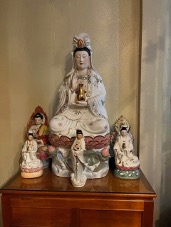
Vietnamese Buddhist Association of San Francisco
Photo, copyright 2023, Anna Hennessey.
The guardian lions at the front of the temple follow the tradition of Chinese Buddhist temples, where lions, believed to be mythical protectors, guard important places such as palaces, temples, and homes of officials. Most often depicted in male and female pairs, the lions both rest a paw on an object. The male, a representation of the Chinese cosmological force of Yang, places his right paw on a ball, the object of which symbolizes earth or the material world. The female, a representation of Yin, complements and mirrors the male, placing her left paw on a cub, the object of which symbolizes life and its cycles.

Vietnamese Buddhist Association of San Francisco
Photo, copyright 2023, Anna Hennessey.
Mrs. Nga Le (Dharma name Thuyen Vi) is Lan Le’s wife and an important member of the Buddhist laity at Tu Quang Temple. Like her husband, she maintains strong historical knowledge of the temple’s founding and operation. She is also closely connected to the temple artwork and is an artist herself. She explains that some of the artwork, including smaller sculptures found within the temple, originated in Taiwan and were imported to San Francisco in 1978 at the time of the temple’s founding. Several of Mrs. Le’s own works hang in the main hall, including three large pieces that she embroidered recently. One of those is a representation of Daishizhi (Mahasthamaprapta), a bodhisattva in the Pure Land sect of the Mahayana tradition.
When practitioners arrive at the temple, they leave their shoes near the entryway to the building. During services and ceremonies, which are conducted in Vietnamese, the practitioners first stand and bow to Master Giác Như as he walks towards the front of the main hall and central shrine. They then sit on the floor, standing, kneeling, and bowing to the Buddha when they hear the deep sound of a bell, which either the Master or one of several Buddhist laity who aid the Master rings during services. Typical services include a lecture during which time the Master discusses Buddhist principles, followed by chanting. After the service, practitioners head to the lower level of the building where they share in a free communal lunch provided by the association.
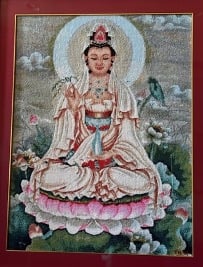
Vietnamese Buddhist Association of San Francisco
Photo, copyright 2023, Anna Hennessey.
On a cool, breezy day in June 2023, Master Giác Như showed me around the building and temple, including areas of the private quarters on the second floor. Small sculptures and other artworks, many of which represent Guanyin, rest in the various rooms. I tell him that the large sculptural relief of Guanyin on the front of the building is what originally drew me to the temple. Guanyin is a bodhisattva, an enlightened being, and the goddess of compassion, mercy, and love.
Smiling and speaking quietly of Guanyin, Master Giác Như discusses the importance of spreading compassion in our world more broadly. At the Tu Quang temple, the monk strives to teach compassion and the care for others within San Francisco’s Vietnamese community and beyond. Since its inception as a place of inclusion, especially for Vietnamese in the diaspora following the Vietnam War, the Tu Quang temple is a living place that evolves with both its people and the city of San Francisco.
About the Author
Anna Hennessey, PhD, is a San Francisco based writer, scholar, and artist with an academic background in religious studies, art history, and philosophy. She has lived and studied in Taiwan, and also traveled in China, exploring Buddhism, Daoism, Confucianism, and local religions. Hennessey lives in San Francisco with her husband, two children, and dog. More information about her publications, artwork, and life is available through her website at: https://annahennessey.com
References
Au Co Vietnamese Cultural Center. “History and Mission.” Accessed November 2, 2023. https://www.aucocenter.org.
Do, Anh. “Vietnamese refugees began new lives in Camp Pendleton’s 1974 ‘tent city.’” Los Angeles Times (Los Angeles). April 29, 2015. Accessed November 16, 2023. https://graphics.latimes.com/tent-city/.
Le, Lan. Interview by Anna Hennessey. Tu Quang Temple. San Francisco, California, June 17, 2023.
Le, Nga. (Dharma name Thuyen Vi). Interview by Anna Hennessey. Tu Quang Temple. San Francisco, California, June 17, 2023.
Li, Han. “San Francisco’s Little Saigon is facing an existential crisis.” The San Francisco Standard (San Francisco). January 22, 2024. Accessed February 2, 2024. https://sfstandard.com/2024/01/22/san-francisco-little-saigon-homeless-center/
Master Thich Giác Như. Interview by Anna Hennessey. Tu Quang Temple. San Francisco, California, June 14, 2023.
Quan Am Nam Hai Monastery. “Most Venerable Thich Tinh Tu (Founder).” Accessed October 15, 2023. https://quanamnamhai.org/grand-master-thich-tinh-tu/.
1 thought on “San Francisco’s Tu Quang Temple: Vietnamese Buddhism and Regeneration in the Heart of the City”
Leave a Comment
More articles by this author
Search
Latest Features
Please support the "Spread the Dharma" mission as one of our heroic Dharma Supporting Members, or with a one-time donation.
Please Help Support the “Spread the Dharma” Mission!
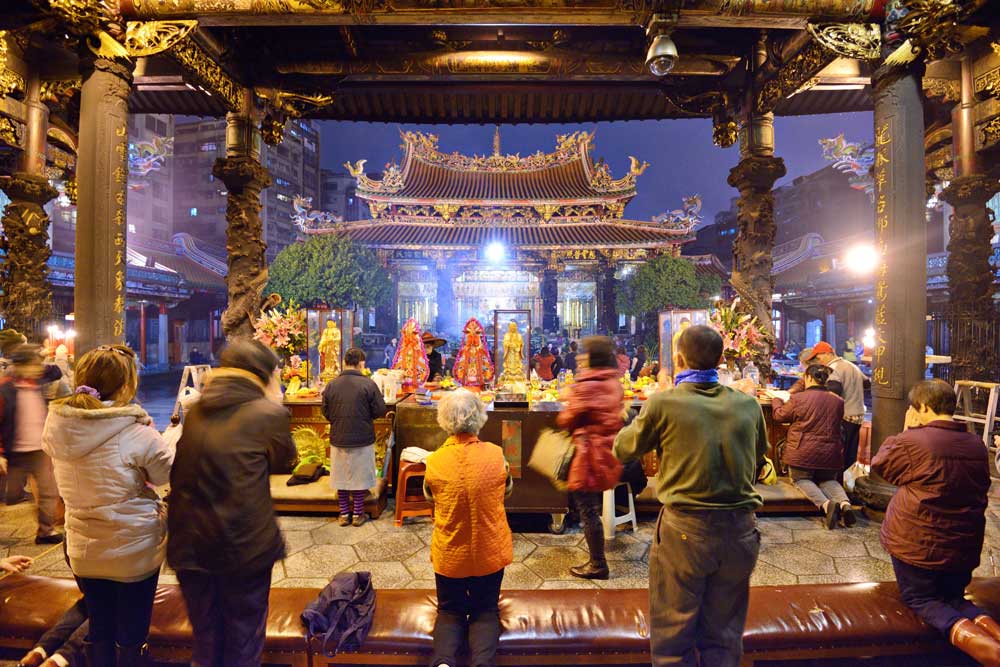
Be a part of the noble mission as a supporting member or a patron, or a volunteer contributor of content.
The power of Dharma to help sentient beings, in part, lies in ensuring access to Buddha’s precious Dharma — the mission of Buddha Weekly. We can’t do it without you!
A non-profit association since 2007, Buddha Weekly published many feature articles, videos, and, podcasts. Please consider supporting the mission to preserve and “Spread the Dharma." Your support as either a patron or a supporting member helps defray the high costs of producing quality Dharma content. Thank you! Learn more here, or become one of our super karma heroes on Patreon.
Anna Hennessey PhD
Author | Buddha Weekly
Anna Hennessey, PhD, is a San Francisco based writer, scholar, and artist with an academic background in religious studies, art history, and philosophy. She has lived and studied in Taiwan, and also traveled in China, exploring Buddhism, Daoism, Confucianism, and local religions. Hennessey lives in San Francisco with her husband, two children, and dog. More information about her publications, artwork, and life is available through her website at: https://annahennessey.com
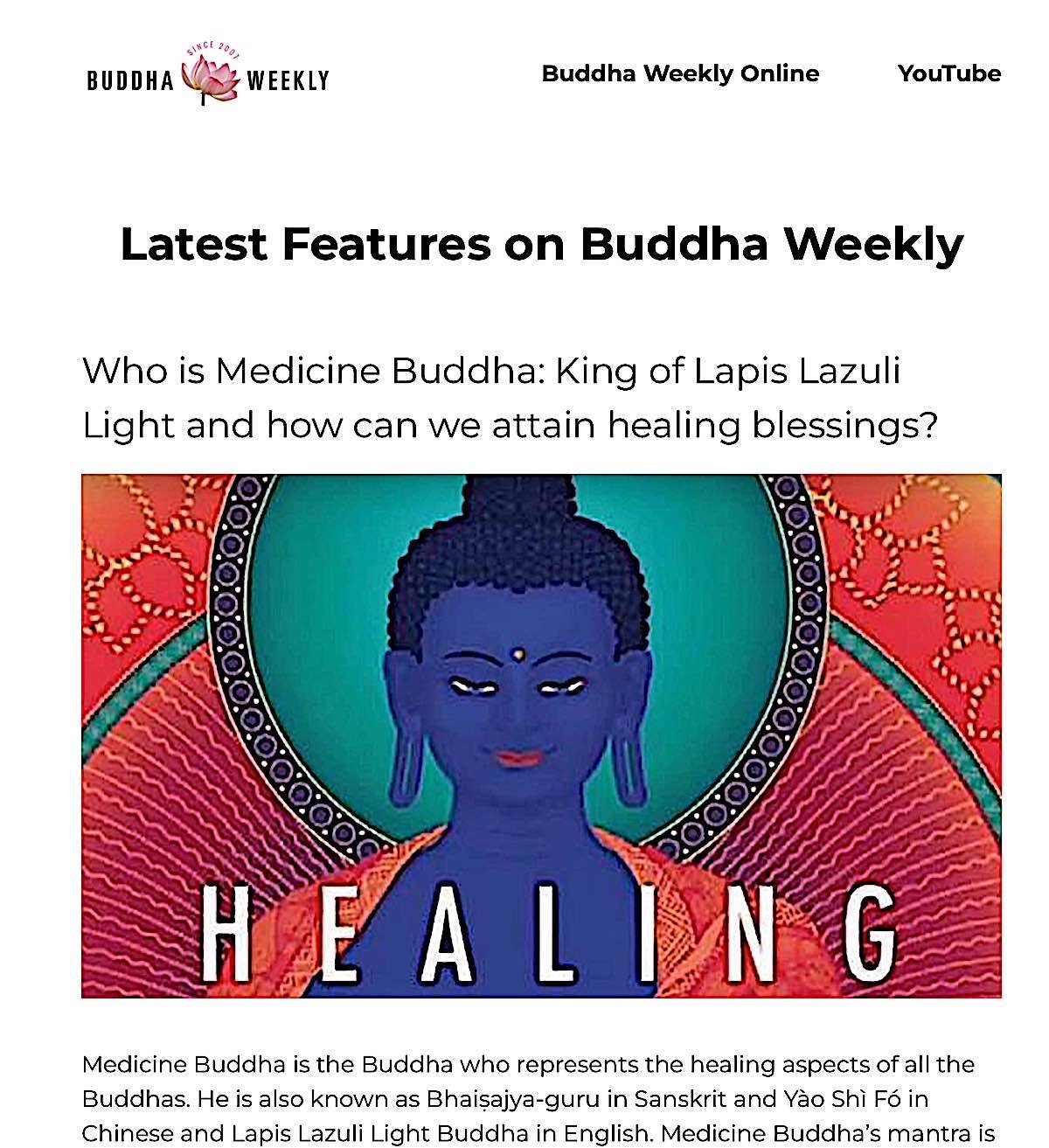
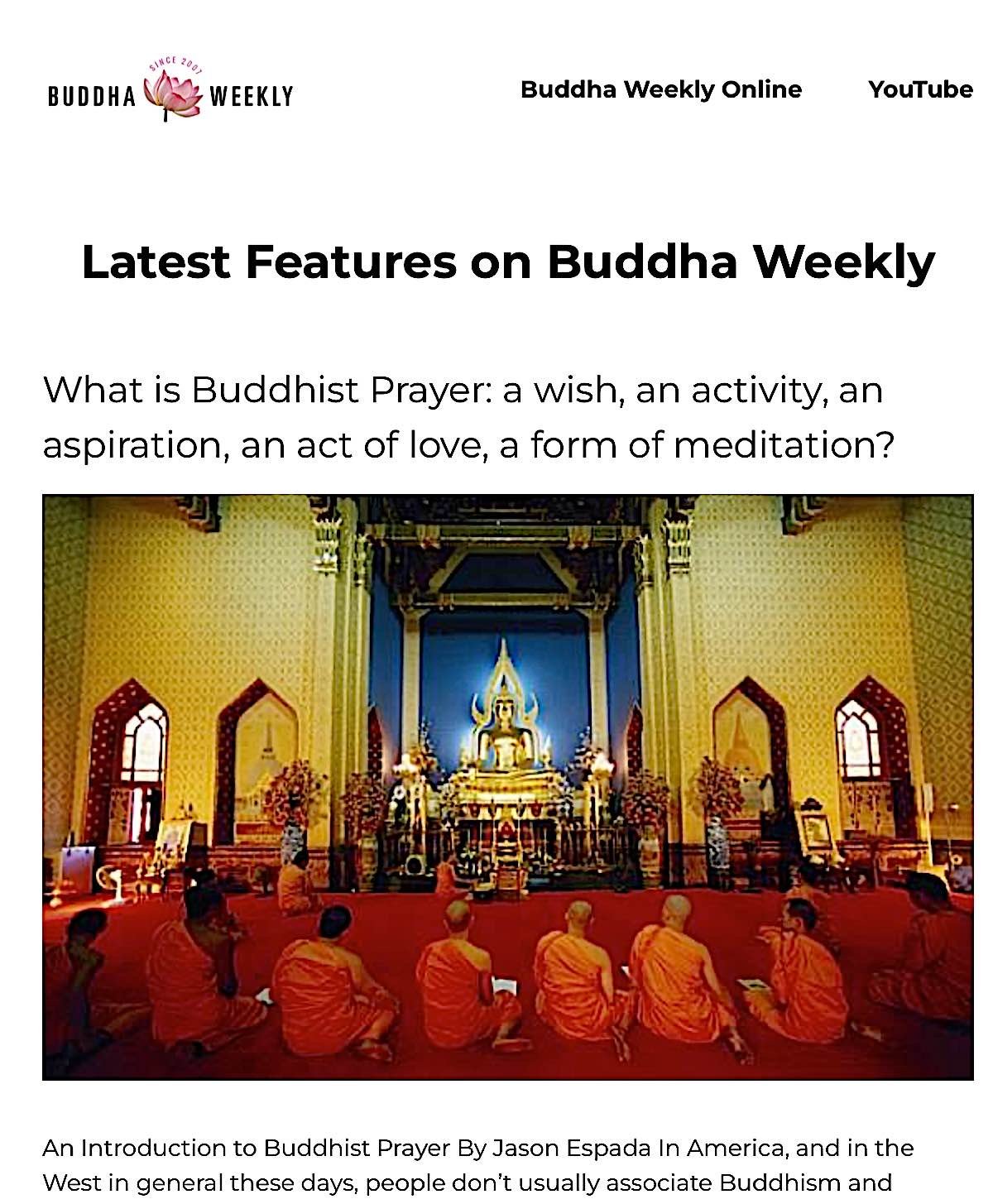



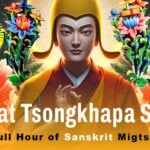
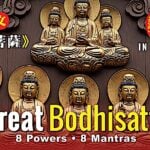
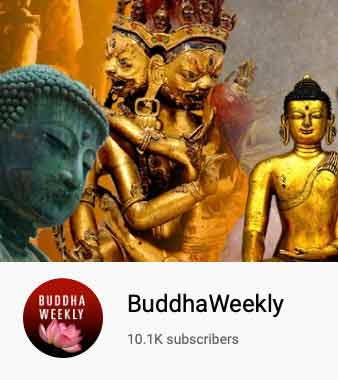
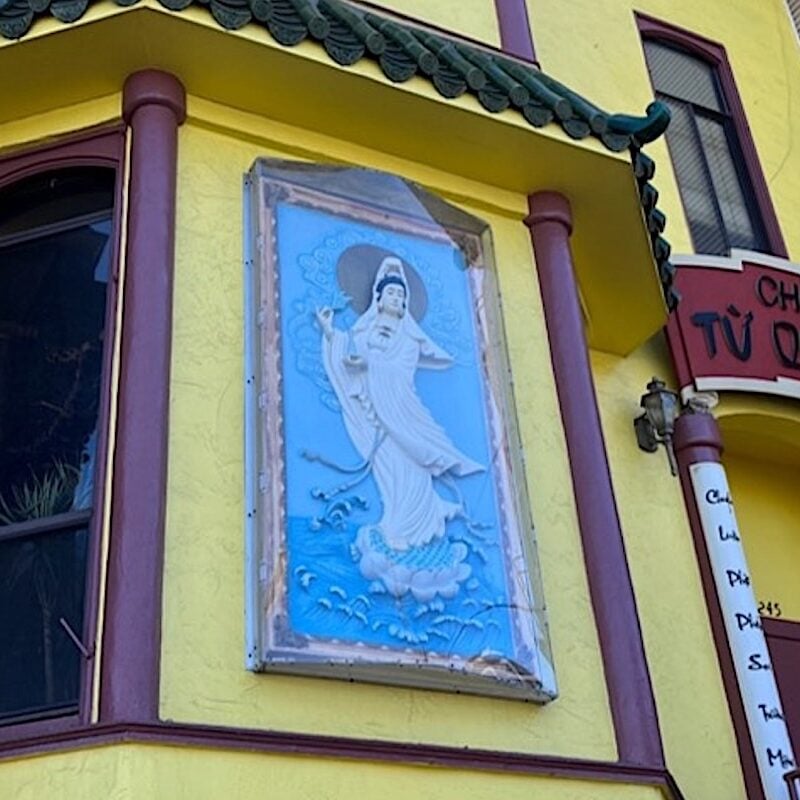
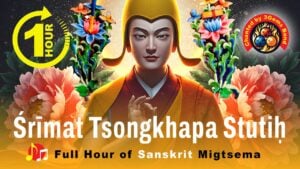
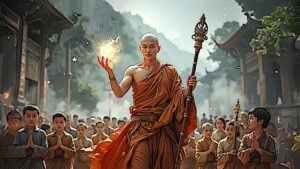



Nice. What’s coming, for the church and its community?